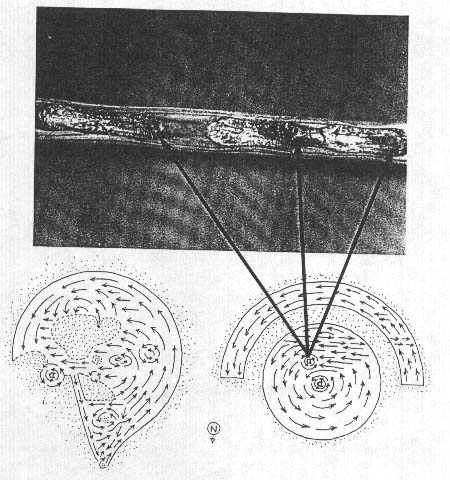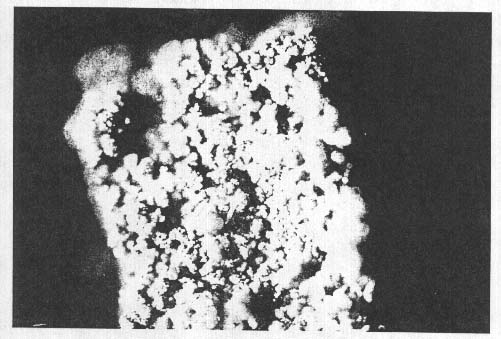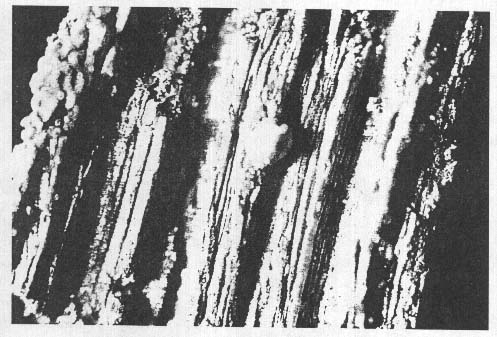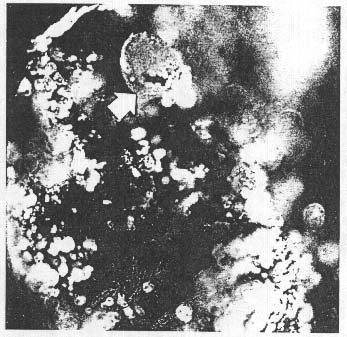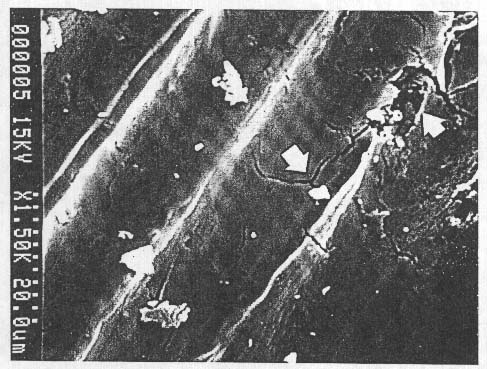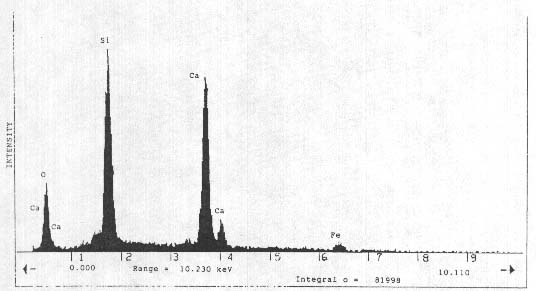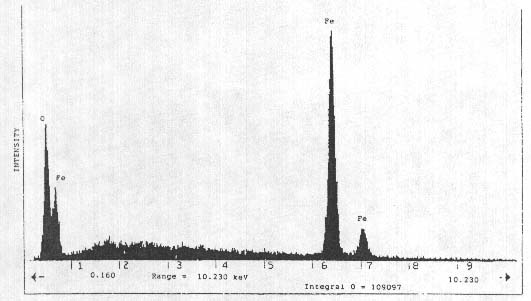Journal of Scientific Exploration, Vol 9, No. 2, pp. 191-199, 1995
0892-3310/95
(c) 1995 Society for Scientific Exploration
Ê 4853 Wolf Lake Rd., P.O. Box 388, Grass Lake, MI 49240, USA c/o BLT Research Team, PO Box 400127, Cambridge, MA 02140 Abstract - We report the unusual discovery of a natural iron "glaze" composed of fused particles of meteoritic origin, concentrated entirely within a crop formation in England, appearing shortly after the intense Perseid meteor shower in August. 1993. Physical and chemical characteristics as well as spatial distributions indicated reheating to a semi-molten state at the time of crop impact. suggesting involvement with an ion plasma vortex, a mechanism pieviously considered the chief candidate in scientific investigations of crop formations. Abnormalities in seedling growth was also consistent with the unusual responses of seeds taken from numerous crop formations. Out of a four year investigation of plant tissues taken from over eighty crop formations. located within five countries, we report data from a single sample set which indicates a "close encounter , between the complex forces producing these flattened, circular type formations and meteoric material from the atmosphere. Both soil chunks and plant tissue taken from specific regions within a 1993, wheat crop formation in Cherhill, Wiltshire, England, exhibited a high degree of magnetic susceptibility which originated within adherent coatings consisting of the commingled iron oxides, hematite (Fe203) and magnetite (Fe304) fused into a heterogeneous mass, and having the properties of a "magnetic-glaze". The makeup of this material appears to be of meteoric origin and apparently impacted the ground while in the semi-molten state. Presence of meteoric material adhering to both soil and plant tissues, casts considerable doubt on this being an artificially prepared or "hoaxed" formation. Field investigator Peter Sorensen of the United States found the magnetic material confined to localized, dust coated plant swirls or vortices approximately 0.5 m in diameter (regions designated D in Fig. I), located within the boundaries of two larger, more typical circular sites of downed plants approximately 15 m in diameter and 60 m apart, both within the same wheat field. The oxide materiail wais first perceived as a "brown stain" or coating, non-uniformly spread over the upper, exposed surfaces of the limestone soil, and within interstices of leaves and stems in the entangled wheat plants. An impacted wheat stem is shown in Figure 1, with its location indicated, relative to the formation complexes. In these three separate, gouged out, impact zones the imbedded magnetic material is in the dark regions as indicated by the arrows. Light microscope examination of the coatings revealed the presence of black, light reflecting particles in the range of 2 to 100 micrometer, with both irregular and spherical shapes, mixed within a red-brown amorphous appearing matrix. The overall semblance suggested a glazed layer. Based on the known properties of the two common forms of iron oxide, the samples were exposed to a small (1700 gauss) horseshoe type magnet. Very pronounced susceptibility was observed in coated regions on the plants and soil. The attraction was sufficient to literally pick up leaves, wheat heads and stems (as in Figure 1) and to cause movement of coated soil chunks 1-3 cm in diameter, when the magnet was brought in proximity. Fig. I. Diagrams (not to scale) showing lay of wheat crop at Cherhill. England. Swirls are approximately 15 m diameter and 60 m apart. within the same field. Arrows extend from a small internal vortex (0.5 m dia.) containing plants with the adherent. imbedded magnetic material, shown in three impact regions on a wheat stem. The layer on the soil was very adherent, whereas, with care, the coating on the plants could be removed as intact flakes. The film thickness ranged from 200 to 400 micrometer on both soil and plants. The outer or air-contacting side of plant fragments (Figure 2a) formed a bubbly heterogeneous mixture. The inner, plant contacting surface (Figure 2b) retained a fixed imprint of the longitudinal fibers and cell structure of the plant epidermal cells. This clearly suggests that the coating material was in a semi-rigid or plastic condition when it contacted the plant surface. The formation of these adherent iron oxide films suggests a spraying type of ablation in the earth's atmosphere (Opic, 1958), and a temperature above 500 oC for Fe304 to condense from cooling gas (Wood, 1981), therefore it seemed important to search for further evidence of high temperature involvement in the magnetic-glaze formation. Within the adherent film on the soil chunks were very thin walled tubules of hematite which appeared to rise up through the glaze and solidify into a hollow dome. In many cases the rounded caps were shattered, with the thin fragments scattered beneath. On occasion these domes were found relatively intact, but, with a wide stress crack (Figure 3a) produced during cooling. This tubulation is more clearly understood when it is considered that limestone is used as a high temperature flux in the smelting of iron. When the oxide mixture strikes the soil there is a very brief fluxino interaction with the limestone substrate, at which time the domed tubes are formed by escaping trapped gasses at the film-soil interface. It is important to note that the less adherent glaze material on the plants does not contain these domed tubules. One might expect that the plant surface under the glaze particle would be severely charred, but, such is not the case, only a faint red hematite stain remains. The high water content of the plant cells would insure the rapid formation of an insulating, steam layer between the plant tissue and the glaze film. In fact, SEM photographs of the plant contacting side disclose deep, elongated pits (Figure 3b, at right arrow) which may have been caused by localized pressure as steam and water rushed out of the stomates and forced a rupturing of the thin glaze. On ceramic pottery, a too rapidly cooling of the thin film glaze, causes a network of very minute stress cracks. One characteristic feature of these so-called "mud-crack" patterns is an approximate 90 o angle at the point of intersection, and they seldom cross one another. The SEM in Figure 3b shows a network of these flaws in the magnetic-glaze, with one region of intersection indicated by the central arrow. As this adherent layer cools and contracts, a temporary tension stress develops in the outer surface of the glaze. The work done in forming this film has been shown to be comparable to theoretically stretching the glaze film over an incompressible sphere (Levengood, 1961), in this case the limestone chunks. The growth and vigor of seeds taken from heads demonstrating the magnetic attraction were compared with control heads taken over 100m from the large formations. The energies within the glaze regions did not adversely affect either the germination or the seedling growth, in fact the rate and uniformity of plant growth were significantly enhanced. This is a situation which is commonly found within seeds taken from crop formations occurring near the late maturity stages (Levengood, 1994). (2a) Heterogeneous mixture of iron oxides on outer surface. (2b) Plant contacting side of the same fragment showing imprint of plant epidermal cell structure (both at 40X). Fig. 2. Surfaces of a magnetic fragment taken off the leaf of a wheat plant. (3a) Arrow indicates the dome of a tubule formed in a flux interaction at the interface between the magnetic coating and the soil substrate. The crack formed as the internal gasses cooled down (100X). (3b) Scanning electron microscope (SEM) view of plant contacting surface of coating, showing region at right arrow where heated gasses escaping from a stomate apparently blew a hole in the film. Central arrow indicates a type of crack pattern typical of a rapidly cooling glaze film (1500X). (3c) Energy dispersive spectroscopy (EDS) of soil substrate on which the adherent, magnetic coatines were found. (3d) An EDS of soil magnetic glaze showing presence of iron and oxygen only. Fig. 3. Surface details indicating high temperature reactions. Energy dispersive spectroscopy (EDS) comparisons between the soil substrate, Figure 3c, and the magnetic coatings, Figure 3d, confirmed the absence of mixing with the soil substrate, as none of the calcium or silica, typical of this chalky soil, were present in the glaze. The presence of iron and oxygen only, suggests a possible meteoric origin, especially as the incident was dated to within a few days of the Perseid meteor shower which in 1993 produced some of the highest activity in years (Brown and Rendtel, 1994). The elements Ni, Cr and Mn, normally significant components within any iron-bearing meteor (Krinov, 1960), were absent in the EDS analyses. This may relate to the fact that heating caused by entry into the atmosphere, produces a "fusion crust". This external coating is composed of magnetite, much of which is ablated as molten droplets which may immediately cool, or become partially oxidized to hematite (Buddhue, 1957). The congealed droplets drift to Earth several days after a major shower (Buddhue, 1961) and have also been found in the soil surrounding known iron meteorite falls (Krinov, 1960) The size range of such spherules is consistent with particles found in the crop formations. X-ray powder spectroscopy of such iron spherules has shown lines of magnetite only (Mason, 1962), while others have shown both magnetite and hematite (Buddhue, 1957). In this context, it should be noted that we are aware of only one similar incident, and that took place on January 8, 1981, approximately 48 hours after the Quandrantid meteor shower (another of the year's active showers). This event, occurring in Trans-en-Provence, France, coated the upper side of limestone rock and soil with a thin plating of iron oxides only (Velasco, 1990). Thus timing, content, and form are all consistent with a meteoric origin. In Cherhill, England, the meteoric dust was confined to separate smaller swirls within the larger swirls. Previous discussion on possible causes of crop circles has centered on a hypothetical plasma vortex comprised of tightly swirling ions of the same diameter as the flattened, swirled area of the field (Meaden, 1991). Meteor trails are so highly ionized that they can be detected by radar (DeAngelis, 1988) and used to enhance radio communications. The structure of these ionized trails is still not well understood, but known to be turbulent (Gibbs, 1983). Plasma processes are commonly seen in the ionosphere within the aurora, many of which are spiral. In fact, the rays of the common aurora are now known to be tight vortices viewed from the side (Hallinan, 1981). While the full scale of an aurora is vastly larger than that of the 15 m crop circle, the thickness is often little more than 100 m. In plasmas, the magnetic pinch effect tends to concentrate the plasma into progressively tighter helical structures. As the overall width of the helix decreases, the local, induced magnetic field increases (Rose and Clark, 1960). Thus, if it were plasma vortices that impacted the English wheat field, the 0.5 m sub-vortices would likely have had stronger magnetic fields than the 15 m vortex of which it was a part. These smaller, high field strength regions could, by a process of plasma convection and chemical separation (Marklund, 1979), form discreet filaments containing the highly magnetic iron dust. Microwaves produced by the electrons rotating in their helical paths would heat any iron particles present and in air would also oxidize a portion to the hematite form. Internal heating may explain why the hematite-magnetite mixture was still semi-rigid on impact. Normally such droplets congeal in the air and reach the surface as independent spherules without plating the ground. Spiral aurorae commonly contain arcs which have been seen to evolve into pairs of counterclockwise vortex sheets (arrays of vortices) that are never stable and never unwind. This compares well with the two, 15 m counterclockwise spiraled areas in the wheat, with their attendant sub-vortices. Helical auroras originate in spiral electric fields of the magnetosphere and map down along geomagnetic field lines into the ionosphere (Hallinan, 1981). Is it possible that a pair of these downward directed, counterclockwise plasma vortices intersected and captured meteoric dust along the way, which in turn was maintained or heated back to a semi-molten state by the microwaves of sub-vortices which carried it to the ground, with its subsequent crop flattening energies? If so, this would indicate a heretofore unknown phenomenon of ionospheric plasma vortices descending to the Earth's surface. Whatever the primary origin, the evidence clearly indicates that meteoric dust impacted the ground while in a semi-molten state and was confined to multiple, tight vortices within flattened wheat formations. We thank Peter Sorensen for his well documented field sampling and observations, and Linda Moulton Howe for coordinating the sample collections. Special thanks to Bart for his valuable assistance in obtaining EDS data and SEM photographs. Brown. P. & Rendtel. J. (1994). 1993: Year of the Perseids. Sky and Telescope. 87, 34. Buddhue, J. D. (I 957). The Oxidation and Weatherig of Meteorites. Albuquerque, New Mexico: University of New Mexico Press, 77. Buddhue, J. D. (1961). Meteoric Dust. Albuquerque, New Mexico: University of New Mexico Press, 82. DeAngelis, K. J. (1988). Thesis, California State University at Long Beach, Gibbs, K. P. (1983). Thesis, University of Illinois. Hallinan, T. J. (1981). Physics of Auroral Arc Formation. American Geophysical Union, Washington, DC., 43. Krinov, E. L. (1960). Principles of Meteoritics . New York: Pergamon Press, 326 and 149. Levengood, W. C. (1961). Defect mechanisms in a non crystalline solid. J. Applied Physics. 32, 2525. Levengood, W. C. (1994). Anatomical anomalies in crop formation plants. Physiol. PIant, 92, 356. Marklund, G. T. (1979). Plasma convection in force-free magnetic fields as a mechanism for chemical separation in cosmical plasmas. Nature, 277, 370. Mason, B. (1962). Meteorites. New York: John Wiley & Sons, 60. Meaden, G. T. (1991). Circles From the Sky. (Ed. Meaden, G. T.). London: Souvenir Press, 11. Opic, E. J. (1958). Physics of Meteor Flight in the Atmosphere. New York: lnterscience Publishing, Inc., 60. Rose, D. 3. and Clark Jr.. M. (1960). Plasmas and Controlled Fusion. Cambridge: MIT Press & New York: John Wiley and Sons, 336. Velasco, 3.1. (1990). Report on the analysis of anomalous physical traces: the 1981 Trans-en-Provence UFO case. Journal of Scientific Exploration, 4, 45. Wood, J. A. (1981). The New Solar System. (Eds. Beatty, J. K., O'Leary. B. & Chaikin. A.). Cambridge. MA; Sky Pub. Corp & United Kingdom: Cambridge University. Presss, 189. Report a Crop Circle |
